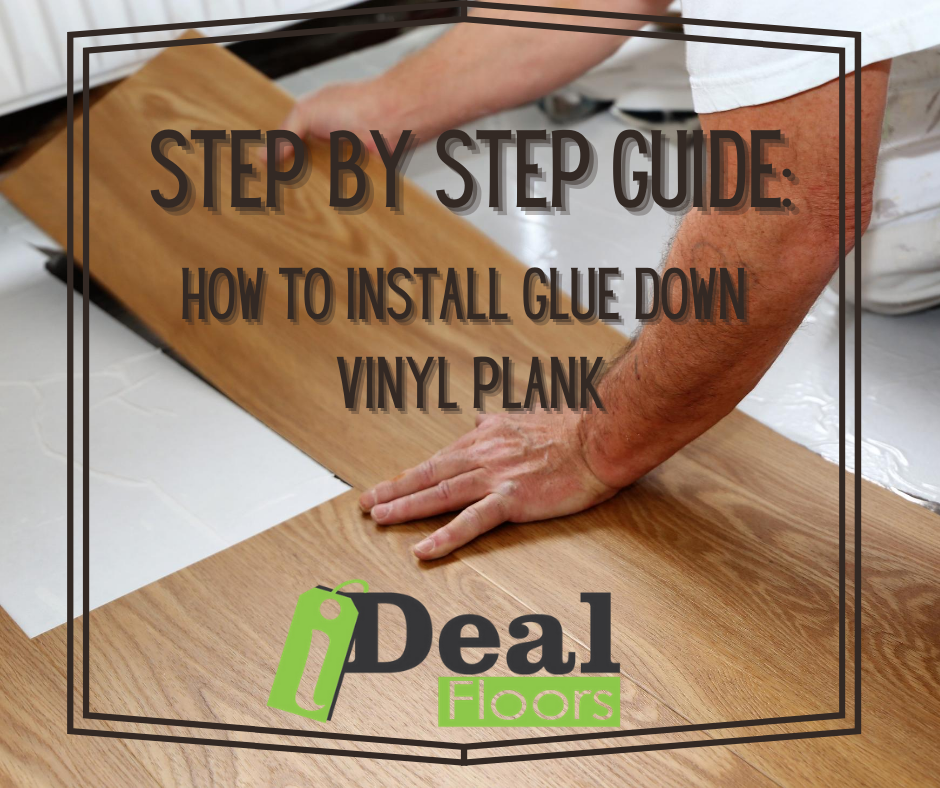Deal Floors Step-by-Step Glue Down Vinyl Plank Installation Guide
Wait - Did you say Glue down vinyl? Why would anyone bother with it these days when we have so many click install products? Although it may take a bit more time to install, the material is most definitely less expensive and this slightly more tedious installation leads to more durability!

Wait - Did you say Glue down vinyl? Why would anyone bother with it these days when we have so many click install products? Although it may take a bit more time to install, the material is most definitely less expensive and this slightly more tedious installation leads to more durability!
Now let's jump into the installation!
Step One: Smooth Sub-Floor
A smooth and flat sub-floor is a necessity here. Vinyl flooring works well in any tightly sealed, smooth or seamless surface. You can remove you previous flooring and use a razor scraper to remove any residue.
However, if your previous flooring is something like tile, it's much easier to lay your vinyl over the tile. Vinyl flooring is the best option for laying over tile because of how thin it is! With vinyl, you won't have to worry about trimming doors shorter or any other added troubles.
Before you decide on this option, be sure your previous floors do not have radiant heat. Glue-down vinyl adhesive doesn't stand up well to high temperatures. We recommend using floating vinyl planks on floors with radiant heat, provided the temperature of the floor stays below 85 degrees Fahrenheit.
In order to do this, you must fill the grout lines with leveling compound, or to lay a new subfloor over the tiles. In fact, because vinyl does not require an underlayment, the extra insulation provided by the tile is a bonus.
Step Two: Preparing Your Tile for Vinyl (Optional)
This step is only necessary if you have tile floors that you are choosing not to remove.
- Chip out any loose grout and clean up the pieces
- Next, prepare a cementitious floor-leveling compound - We suggest Henry 555 Level Pro or LevelQuik Self-Leveling Underlayment.
- Grab a bucket and add water until the mixture is pourable.
- Spread the mixture onto the floors with a trowel or float until the entire floor has more or less the same amount of material and is flush with the tops of the tiles. Your goal is an even floor!
- Grab a long, straight 2x4 and lay over your floor to level it. Try to do this before your mixture hardens (about 30 minutes after mixing).
- Let the mixture dry thoroughly before installing the tiles. This could take 24 to 48 hours depending on the temperature and humidity.
If you think you may want to uncover your tile later on, you can glue down a layer of 1/4" to 1/2" plywood on top of your tile instead. Be sure to make sure this won't raise your flooring level too much!
Some floors will call for a paint-on primer prior to installation. This primer fills pores in the subfloor and helps the adhesive stick more effectively.
Step Three: Sweep, Vacuum, Repeat!
This step is that simple, be sure there are no debris, dust, or anything that will cause your glue not to adhere well to your flooring!
Step Four: Prep and Adhesive
Every brand of vinyl plank flooring comes with specific set of installation instructions, be sure to follow them. However in general, vinyl flooring should be installed with a quarter-inch to half-inch perimeter where the flooring meets the wall, allowing for proper expansion in warmer months.
- Baseboards should be removed prior to installation, and only replaced after the vinyl is completely set.
- If you can finish the room in one setting, go ahead and spread the pressure sensitive adhesive to the ground using a trowel. Do not use too much or it will ooze in between each plank.
- If you cannot finish the room in one setting, lay out five or six boards against a wall and chalk a straight line along the end. Measure the distance, and chalk a straight line of the same distance starting from another parallel wall.
This way you have sections to begin with and don't glue past where you're ready to lay down vinyl. Fill in your sections with adhesive.
Step Five: Laying Planks
- If you are finishing the room in one setting (tiles must be laid within 2 hours of adhesive application), begin in the middle of your floor, laying down one row at a time. The adhesive does not allow for each plank to slide so be sure to place each plank down carefully next to the previous one.
- Gently press each plank into the adhesive so that they fully bond. You can use a vinyl floor roller. Try kneeling onto a piece of plywood instead of directly onto the vinyl in order to add more even pressure to the flooring.
- If any adhesive oozes out, be ready with a damp rag to immediately wipe it up.
- As you continue, measure and cut pieces to fit the rest of your room.
Step Six: Post Installation
- Keep an eye on your floors to make sure each plank is tight against the other and no adhesive is oozing out.
- Allow your floors a few hours to bond before walking on them.
- Do not wash your floors for the first week so that the adhesive can fully settle.
Step Seven: Enjoy your Craftsmanship!
Enjoy your beautiful new floors and brag on your hard work! You deserve it!
Now that you're a click vinyl plank installation pro, all you need is the flooring itself! Click here to get a free estimate and one on one help with one of our expert specialists!


Comments